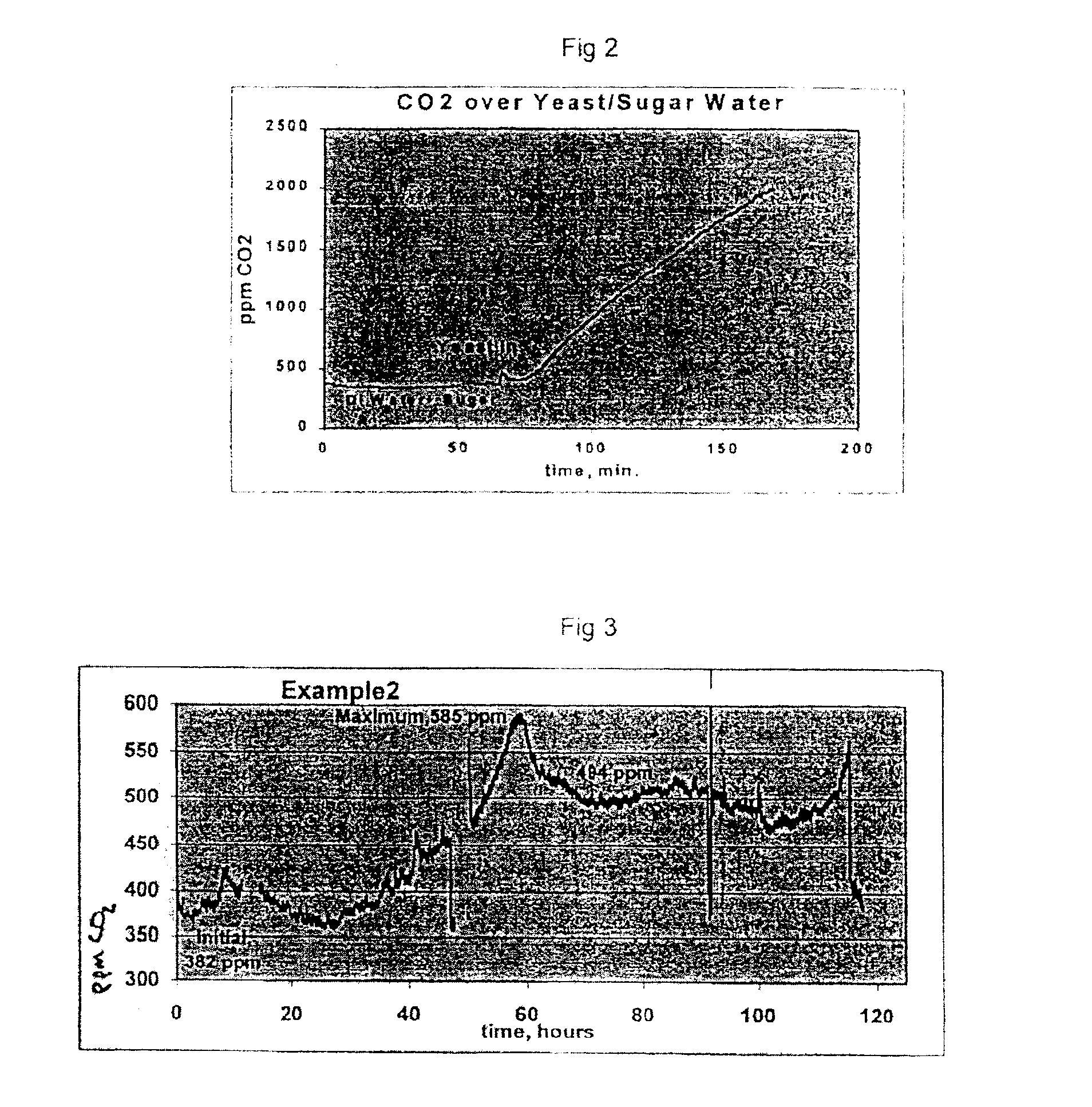Method and device for detecting and controlling the level of biological contaminants in a coating process
a technology of biological contaminants and coating process, which is applied in the direction of electrophoresis, electrolysis, isotope separation, etc., can solve the problems of reducing system performance, adversely affecting the quality and appearance of the electrodeposited coating, and affecting the appearance of the coating
- Summary
- Abstract
- Description
- Claims
- Application Information
AI Technical Summary
Problems solved by technology
Method used
Image
Examples
example 1
This example illustrates the feasibility of measuring the carbon dioxide level of the atmosphere above a liquid in a system which is not isolated from the ambient atmosphere.
A one gallon (3.8 liters) plastic paint container, 8.0 inches (20.3 cm) high with a diameter of 6.25 inches (15.9 cm), was used as a sample containment vessel. A growth medium of 10.66 g of Domino® granulated sugar dissolved in 1304.0 g of deionized water was added to the containment vessel. The growth medium occupied about one third of the vessel volume. The remainder of the vessel volume was ambient air. A lid having a 0.25 inch (0.64 cm) hole with a piece of Tygon™ tubing (“sample tubing”) of 0.25 inch (0.64 cm) diameter and a length of about 50 inches (105 cm) attached thereto was loosely placed over the top of the vessel, i.e., the interior of the vessel was not isolated from the ambient atmosphere.
A Guardian™ Plus Infra-Red Gas Monitor System, commercially available from Edinburgh Instruments of Livingston...
example 2
The experimental system described in Example 1 was next used to determine if biological contamination could be detected in a liquid including components found in a typical electrocoating system.
Since, as discussed above, the growth of bacteria, such as Pseudomonas Aeruginosa, in conventional electrocoating systems is believed linked to the level of organic acids, such as acetic acid and lactic acid, in the coating composition, a “sample coating medium” containing acetic acid and lactic acid to simulate a coating composition was prepared for testing. The sample medium comprised a mixture of dihydrogen phosphate (commercially available from Aldrich Chemical Co.), sodium ammonium phosphate (commercially available from Fisher), L-(+)-Lactic acid (90%, commercially available from Arcos Company), and acetic acid (glacial, commercially available from Aldrich Chemical Company). These materials were mixed into distilled water to give the overall composition set forth in Table 1 below (all va...
example 3
This example illustrates the detection of biological contamination in a liquid which had been purposely contaminated with a sample of an electrodeposition coating composition which was known to be biologically contaminated.
A “sample medium” similar to that of Example 2 containing acetic acid and lactic acid was prepared from a mixture of dihydrogen phosphate (commercially available from Aldrich Chemical Co.), sodium ammonium phosphate (commercially available from Fisher), L-(+)-Lactic acid (90%, commercially available from Arcos Company), and acetic acid (glacial, commercially available from Aldrich Chemical Company). The pH of the mixture was adjusted to 7.0 with aqueous potassium hydroxide (commercially available from Fisher Scientific). The resulting mixture contained the following components (all values are in ppm):
TABLE 2Na+140.4NH4+127.3K+127.3Phosphate580.0Acetate97.8Lactate23.5
One thousand grams of this sample medium were placed in the empty containment vessel and an initial...
PUM
| Property | Measurement | Unit |
|---|---|---|
| voltages | aaaaa | aaaaa |
| voltages | aaaaa | aaaaa |
| voltages | aaaaa | aaaaa |
Abstract
Description
Claims
Application Information
 Login to View More
Login to View More - R&D
- Intellectual Property
- Life Sciences
- Materials
- Tech Scout
- Unparalleled Data Quality
- Higher Quality Content
- 60% Fewer Hallucinations
Browse by: Latest US Patents, China's latest patents, Technical Efficacy Thesaurus, Application Domain, Technology Topic, Popular Technical Reports.
© 2025 PatSnap. All rights reserved.Legal|Privacy policy|Modern Slavery Act Transparency Statement|Sitemap|About US| Contact US: help@patsnap.com



